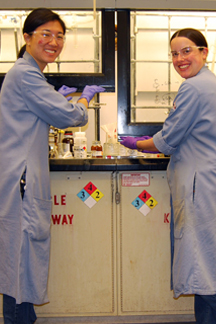‘Shut the Sash’ to Conserve Institute’s Resources, Preserve Environment
By Cindy Brauer and Mika Ono
In a bid to dramatically cut energy consumption and save a potential $250,000 in annual costs, The Scripps Research Institute’s Green Team and Student Sustainability Initiative (SSI) have launched a “Shut the Sash” campaign, urging scientists to close fume hood sashes when not in use.
“This is money that literally is going up and away,” said Scripps Research President Michael Marletta, “and so I strongly welcome a program that conserves resources in such a simple way.”
“We really appreciate the scientists who are already making the effort to close their sashes when not in use,” said Vice President of Facilities Services Pete Herold. “We want to get the word out that this simple behavior has a significant impact on energy costs for the institute. It’s also the environmentally responsible thing to do.”
Intended to protect lab members conducting experiments or related activities, fume hoods draw air from the room up and out through exhaust vents. While providing important ventilation when scientists are working at the bench, many of the hoods (specifically variable air volume models) also offer the opportunity to reduce energy usage when not in use. All that’s required is placing the hood’s sash in the closed position.
Kicking Off the Campaign
In a presentation at a February Scripps Research safety officers meeting, SSI members Shelby Ellery, research associate in the Fokin lab, and Vicki Chang, graduate student in the Nicolaou lab, kicked off the “Shut the Sash” campaign. In addition to introducing the slogan “Green Up, Sash Down,” the pair presented a strong case for the importance of shutting the sash when not in use.
Open hoods consume three to four times as much energy as an entire house in a single day, they noted. Using the Laboratory Fume Hood Energy Model calculator provided by Lawrence Berkeley National Laboratory (see http://fumehoodcalculator.lbl.gov/), the team calculated hundreds of thousands of dollars of potential savings for the institute if all scientists lowered their sashes when away from the hood.
Other institutions have had significant success with their Shut the Sash campaigns, they continued. Harvard reduced the average fume sash height from 12 to 2.4 inches. MIT’s campaign saved an estimated $300,000 per year with lower sash heights. Cal Tech reduced costs by an average of $3,412 per hood per year (with 800 hoods at Cal Tech, that’s $2.7 million annually in savings).
To promote the campaign, SSI members will visit California campus labs to provide reminders, conservation tips, and help with problematic hoods.
Send comments to: press@scripps.edu














